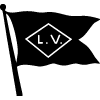 | |
 Map of Lehigh Valley Railroad routes | |
| Overview | |
|---|---|
| Headquarters | Lehigh Valley Railroad Headquarters Building, Bethlehem, Pennsylvania, U.S. |
| Reporting mark | LV |
| Locale | New Jersey, New York, Pennsylvania |
| Dates of operation | 1846–1976 |
| Successor | Conrail (main line and branches lines were transferred to Norfolk Southern Railway and CSX; remaining Locomotives to Norfolk Southern) |
| Technical | |
| Track gauge | 4 ft 8+1⁄2 in (1,435 mm) standard gauge |
The Lehigh Valley Railroad (reporting mark LV) was a railroad in the Northeastern United States built predominantly to haul anthracite coal from the Coal Region in Northeastern Pennsylvania to major consumer markets in Philadelphia, New York City, and elsewhere.
On April 21, 1846, the railroad was authorized to provide freight transportation of passengers, goods, wares, merchandise, and minerals[1] in Pennsylvania. On September 20, 1847, the railroad was incorporated and established, initially called the Delaware, Lehigh, Schuylkill and Susquehanna Railroad Company.
On January 7, 1853, the railroad's name was changed to Lehigh Valley Railroad.[2] It was sometimes known as the Route of the Black Diamond; black diamond is a slang word for anthracite, the high-end type of Pennsylvania coal that it initially transported by boat down the Lehigh River.
The Lehigh Valley Railroad's original and primary route between Easton and Allentown was built in 1855. The line later expanded past Allentown to Lehigh Valley Terminal in Buffalo and past Easton to New York City, bringing the Lehigh Valley Railroad to these metropolitan areas. By December 31, 1925, the railroad controlled 1,363.7 miles of road and 3,533.3 miles of track. By 1970, this had dwindled to 927 miles of road and 1963 miles of track.
The first small repair shops for locomotives and cars were located in Delano, Wilkes-Barre, Weatherly, Hazleton, and South Easton. In 1902 these were mostly consolidated into the shops at Sayre, Pennsylvania on the New York State border, which featured a 750 by 336-foot machine shop with 48 erecting pits. Meanwhile, the shops at Packerton, Pennsylvania (north of Allentown) acted as the primary freight car shops.
Conrail maintained the line as a main line into the New York City area. The line became known as the Lehigh Line during Conrail ownership. Conrail abandoned most of the route in New York State to Buffalo after 1976, considerably shortening the line.
The majority of the Lehigh Line is now owned by the Norfolk Southern Railway (NS) and retains much of its original route in eastern Pennsylvania and New Jersey, although it no longer goes into New York City. The former Lehigh Valley tracks between Manville, New Jersey, and Newark are operated separately by Conrail Shared Assets Operations as their own Lehigh Line.
In 1976, the railroad ended operations and merged into Conrail along with several northeastern railroads that same year.
- ^ Gerard 1946
- ^ Cite error: The named reference
US570was invoked but never defined (see the help page).
© MMXXIII Rich X Search. We shall prevail. All rights reserved. Rich X Search
